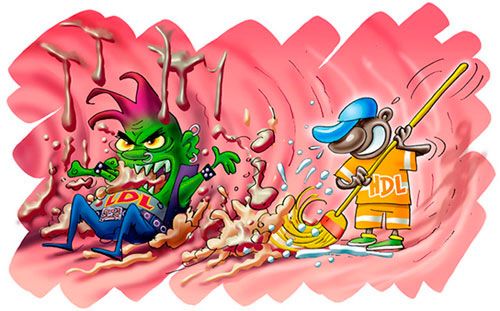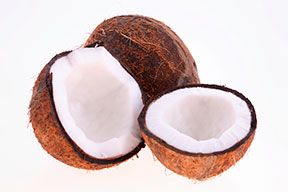
Cholesterol is the great unknown and the benefits of paleo.
Content of the article:
What it is and what it is for
We all need cholesterol
This soft, waxy substance is found not only in the blood, but in every cell of our body, where it helps to produce cell membranes, hormones, vitamins and bile acids that enable us to digest fats. Cholesterol also helps us in memory formation and is vital for neurological function.
The liver makes about 75% of the cholesterol in our body, and according to traditional medicine, there are two types of cholesterol:

High-density lipoprotein (HDL): This is good cholesterol that helps us keep cholesterol away from the arteries and removes all excess from arterial plaque so that it can prevent heart disease.
Low-density lipoprotein (LDL): the bad cholesterol that circulates in the blood, which is generally believed to form plaque that makes the arteries narrower and less flexible (atherosclerosis)
In addition, to populate the total cholesterol table we have:
Triglycerides. High levels of these fats have been linked to heart disease and diabetes. Triglyceride levels are known to be elevated in those who consume a lot of grains and sugars, are physically inactive, smoke, drink alcohol, and are overweight or even obese.
Lipoprotein (a) or Lp (a): lLp (a) is a substance produced by the portion of LDL cholesterol added to a protein (apoprotein A-1). High Lp (a) levels are a risk factor for cardiovascular disease. Today this is confirmed by the fact, but today few doctors control these values in their patients.
What is HDL cholesterol for?
HDL Cholesterol:
- Binds bacterial endotoxins, especially lipopolysaccharide (LPS), and neutralizes their toxicity. As a result, in people with high HDL levels, inflammation is significantly reduced during infections.
- Recovers blood toxins such as oxidized cholesterol and transports toxins to the liver for detoxification. HDL particles that carry toxins are much more welcomed by the liver than HDL particles without toxins.
Benefits of HDL Cholesterol:
According to Paul Jaminet, the optimal HDL value should be around 70. However, most people have triglyceride levels too high and HDL levels too low. Low triglycerides and high HDL levels are closely linked to longevity.

In older adults, high HDL is associated with the ability to walk faster and more balanced due to better cognitive function.
Total cholesterol levels below 200 indicate decreased immune function. When total cholesterol is low (less than 200), possible causes include:
- Low fat diet, macrobiotic diet. If that’s a problem, increase your fat intake.
- Hyperthyroidism that can be relieved by lithium supplementation
- Infection with protozoa, fungi or parasites that feed on lipoprotein particles.
When HDL and total cholesterol levels are high, it could mean a decreased ability to get rid of LDL particles in the blood. Possible reasons include:
- Hypothyroidism or lack of iodine or selenium. Thyroid hormones are needed to activate the LDL receptor to allow cells to remove LDL cholesterol from the blood. Iodine supplementation significantly lowers total cholesterol, LDL cholesterol and triglycerides.
- Insufficient sun exposure reduces the production of vitamin D and other sterols from cholesterol.
- Excessive oxidation of LDL cholesterol beyond the ability of macrophages to “cleanse” oxidized LDL.
Cholesterol and inflammation
High cholesterol values are also associated with the incidence of cardiovascular disease.

What causes inflammation? It’s not fat, it’s carbohydrates. Sugar and refined carbohydrates are first on the list, but grains and starches also contribute to this problem. LDL cholesterol does not increase proportionally with increased consumption of saturated fat, but it does increase with increased levels of inflammation caused by carbohydrates and hydrogenated fats.
In addition, almost all studies show that LDL cholesterol is only a real threat when oxidized (by free radicals). Basically we are talking about hydrogenated fats. To fight free radicals, it is necessary to consume antioxidants such as vegetables, fruits, nuts, olive oil, etc.
When triglyceride levels in the blood are high (usually due to high carbohydrates in food, causing excessive insulin secretion), VLDL (Very Low Density Lipoprotein) production increases dramatically to cope with the abnormality, and many of these particles can turn into small dense particles of LDL (most dangerous). It was found that the latter are particles of cholesterol that can adhere to the walls of arteries and then oxidize and become inflamed. The atherosclerotic process is further accelerated by the consumption of PUFAs, which are very easily oxidized. A low carb diet can help reduce these dangerous particles.
The conventional wisdom on this topic is completely wrong. While it is true that cholesterol-lowering drugs (statins) or a low-fat and / or vegetarian diet can lower triglyceride and cholesterol levels in the blood, a diet that excessively increases insulin will have an inflammatory and oxidative effect on all small and dense LDL that is still present. “Unfortunately,” there is the example of journalist Tim Russert, who died of a heart attack in 2008 at the age of 58, despite having extremely low total cholesterol (105 mg / dL) from statin use.
Ultimately, there is no direct link between consumption of cholesterol and saturated fat and heart disease, the conventional hypothesis that fats damage the heart only occurs if it is present in the blood for extended periods of time. time, excessive amounts of glucose and insulin.
Low cholesterol, statins, inflammation and heart
This study shows that most people with heart attacks have low cholesterol!
Everyone is busy trying to lower their cholesterol and get statins to save people, but the vast majority of heart attacks occur in people with low cholesterol!
Surprisingly, statins reduce heart attack rates in patients with low cholesterol.
What is the mechanism? A decrease in the level of C-reactive protein, a marker of systemic inflammation, is possible.
Do you know what else can reduce systemic inflammation? The Paleo diet, which controls insulin levels, eliminates irritating gut foods, and restores the balance between omega-3 and omega-3 fatty acids 6. Increase vitamin D levels and sleep hours. This deactivates the inflammatory factors that cause cardiovascular disease, cancer and neurodegeneration.
Experts say …
Saturated fat and cholesterol
Not everyone may know that there are 4 different types of saturated fat, each of which has a different effect on cholesterol levels:
- lauric acid
- myristic acid
- Palmitic acid
- Stearic acid
Early studies in this regard supported the idea that myristic and palmitic acids generally increase total cholesterol, lauric acid causes a slight increase, while stearic acid does not cause any increase in cholesterol. Back then, experiments predicted that patients would only consume the food they were given and nothing else. All meals have been designed to be able to precisely control the types of fat consumed. Subjects who did not follow the rules were excluded from the group.
Therefore, the accuracy and reliability of these experiments is beyond question, and the conclusion that these saturated fats increase cholesterol levels is clear. However, these experiments had serious limitations. The main point was that the final value was measured only for total cholesterol, incomplete and misleading data. Today we know that this number in itself means little, but apparently, at the time, they thought differently.
In fact, the level of total cholesterol in the blood is of low significance as an indicator of cardiovascular risk and does not reflect the dynamics of the level of cholesterol in the blood.
The ratio of total cholesterol / HDL cholesterol is the best index of cardiovascular risk and is even more revealing if we know the state of inflammation.

Dr.Hugh MacDonald Sinclair’s experiment involved introducing a low-fat meat diet for 5 weeks with only fat added during the fourth and fifth weeks, maintaining the same calorie intake throughout the duration of the experiment. As a result, total cholesterol increased during the fourth and fifth week (which corresponds to an increase in fat), leading the author of the experiment to conclude that “Saturated fat increases total cholesterol. “At the end of the study, Dr. Sinclair did not give a value for the ratio of total cholesterol to HDL cholesterol, but it can be calculated.
In the end, it is observed that: “Adding saturated fat to the diet did not lower total cholesterol, but improved the relationship between total cholesterol and HDL.”
If we were to focus only on the analysis of total cholesterol, we would say that saturated fat increases the risk of cardiovascular disease. But looking at the overall cholesterol / HDL ratio, we understand that this is the exact opposite.
This problem was found in most studies of cholesterol from the 1960s to the late 1980s, that is, given a single value (total cholesterol) that has led us to misleading conclusions that still stand the test of time.
A meta-analysis (a search combining different studies) published in 2010 by physicians and Mzaffarian Misha of the Harvard School of Public Health found that when carbohydrates are used in the diet to replace saturated fat, carbohydrates increase the risk of cardiovascular disease by by increasing triglyceride levels and lowering HDL cholesterol. In addition, this study found that replacing saturated fat with carbohydrates did not increase or decrease the relationship between total cholesterol and HDL cholesterol. In fact, compared to carbohydrates, saturated fats appear to have a neutral effect; they do not cause any increase or decrease in cardiovascular risk. Finally, when fatty acids were compared to carbohydrates, lauric, myristic, and stearic acids were shown to lower (i.e. improve) the ratio of total cholesterol to HDL cholesterol.
The authors of the study concluded that their study with this “scandalous” statement:
These meta-analyzes show that there is no effect on heart disease caused by saturated fatty acid intake.
Total cholesterol and LDL cholesterol
Saturated fatty acid intake and cardiovascular risk is a highly controversial topic. In recent years, many researchers have suggested that increasing intake of certain saturated fatty acids (lauric, myristic, and palmitic acids) lowers the activity of the LDL receptor and therefore leads to an increase in blood LDL levels, which is a factor that has been associated with increased cardiovascular vascular risk. Secondly, stearic acid is able to lower the level of LDL in the blood. Whatever the “truth,” this point of view is oversimplified, as there are many other factors that contribute to the development of cardiovascular disease, such as: 
- smoking,
- lack of exercise,
- Consumption of hydrogenated fats,
- an unfavorable relationship between omega-6 and omega-3
- free radicals,
- lack of nutrients
- homocysteine,
- alcohol consumption,
- and chronic inflammation, among others.
In addition, some research suggests that there is insufficient scientific evidence to support the fact that raising total or LDL cholesterol is an independent risk factor for cardiovascular disease, but oxidized LDL cholesterol is the real culprit. Plaque production is mediated by oxidized LDL cholesterol, not LDL cholesterol. Oxidized LDL cholesterol can cause the inner layer of an artery, called the glycocalyx, to separate. At this point, oxidized LDL enters the artery. Oxidized LDL cholesterol is “eaten” by macrophages, a process known as phagocytosis, which causes macrophages to turn into foam cells that form a fibrous layer.
To cause an ischemic event, the fibrous layer must be damaged. Lectins and chronic inflammation are involved in the activation of matrix metalloproteinases, which break down the fibrous layer.
Thus, high levels of total or LDL cholesterol do not increase the risk of cardiovascular disease; rather, it is oxidized LDL cholesterol that increases the risk of cardiovascular disease. The production of oxidized LDL cholesterol requires the intervention of the above factors. Thus, saturated fatty acid intake is not a problem if we check the other factors listed.
Research by Paul Jaminet and Lauren Cordain on hunter cholesterol -collectors
Is it true that the Paleolithic hunter-gatherer era had lower cholesterol levels? As far as I know, this idea originated and was promoted by the parents of the paleo diet, Boyd Eaton and Lauren Cordain. This information first appeared in a 1988 study by Boyd Eaton, Melvin Conner, and Marjorie Shostak entitled Stungers on the Fast Track: Chronic Degenerative Diseases from an Evolutionary Perspective.
The published study contains 101 bibliographic references, spread over 11 pages, but never mentions cholesterol levels in Paleolithic men.
The letter signature indicates that total cholesterol is 70 to 140 mg / dL in hunter-gatherers, and LDL cholesterol is 35 to 70 mg / dL. However, this statement and this data are not referenced.
The study cites claims that LDL cholesterol is typically about half of total cholesterol and that modern Americans have total cholesterol around 208 and LDL cholesterol around 130, but there is no mention of hunter-gatherer levels in the Paleolithic era. p>
The data in this graph is extrapolated from publications by Eaton, Konner and Shostak. In all cases, none of these publications mentions the above statement.
cholesterol LDL and cardiovascular disease
According to Chris Kresser, these are the main causes of high LDL cholesterol levels that can increase the risk of cardiovascular disease:
- insulin resistance
- Decreased thyroid function
- Infections
- Increased intestinal permeability (leaky gut)
- Genetics
Peter Attia on endogenous and exogenous cholesterol
Cholesterol intake through many foods we eat, and our body produces (“synthesizes”) cholesterol through various precursors. Approximately 25% of our daily cholesterol requirements (300 to 500 mg) come from what we eat (exogenous cholesterol), and the remaining 75% (approximately 800 to 1200 mg) is produced by the body (endogenous cholesterol). To better understand these numbers, we must take into account that the total cholesterol stores in our body range from 30 to 40 grams, and that most of them are found in cell membranes. Every cell in the body can produce cholesterol, and therefore very few cells need a supply of cholesterol. Cholesterol is essential for all cell membranes to produce steroid hormones and bile acids. It is also important in the synthesis of vitamins.
Cholesterol is absolutely essential for our survival. Every cell in our body is wrapped in a membrane. These membranes are responsible for fluidity and permeability; They mainly control how a cell moves, how it interacts with other cells, and how it carries important “things”.
Mark Sisson on cholesterol and inflammation
The inhabitants of the Japanese island of Okinawa turn out to be one of the healthiest groups in the world. The incidence of cardiovascular diseases is extremely low, although they tend to have high cholesterol levels.
The fact is that everything is related to inflammation. Inflammation is a major contributor to cardiovascular disease. And this is already a fact, but little attention is always paid, and no special treatment or prevention. To check the level of inflammation, there is a test called C-reactive protein (CRP) through a blood collection. It’s just a marker, but it can tell us a lot.
About total cholesterol
What are they saying? Try to keep your total cholesterol level below 200, otherwise sooner or later it will be a heart attack.
This statement makes no sense. While epidemiological evidence suggests 200 to 240 mg / dL total cholesterol is better for limiting all-cause mortality, we cannot fully agree. First of all, the value of total cholesterol is limited, since it only tells us about the amount of cholesterol that all lipoproteins contain, without saying anything about the type of lipoproteins that we have or that exist.
Second, total cholesterol is limited as it is defined by a strange formula (C-HDL + LDL – C + Triglycerides / 5) that lowers different types of blood lipids, each with a different role in the body and a single effect on risk contracting the disease in prime numbers. A person with low HDL cholesterol and high triglycerides can easily have the same total cholesterol as someone with high HDL and low triglycerides. Therefore, even if used to predict iron disease or health conditions, total cholesterol alone is irrelevant.
Dr. Joseph Mercola on cholesterol and cardiovascular risk
According to Dr. Mercola, total cholesterol levels are not a good indicator of cardiovascular risk.
Laboratory tests show a maximum value of 200 for total cholesterol as optimal for reducing cardiovascular risks. What is not said is that total cholesterol is meaningless if the value is less than 330.
For the past 20 years, cholesterol has been accused of demonizing entire food categories (such as eggs and saturated fat) and blamed for all cases of heart disease. Something to have as little as possible so as not to suffer the consequences.
On the other hand, even today, the myth that fat and cholesterol are some of the worst foods you can eat remains unchanged. Also! You should know that these are myths that must be refuted, because this is what is harmful to your health.
Not only cholesterol (most likely) will not harm our health (as we are accustomed to believe), but it is not the cause of cardiovascular disease.
Robb Wolf HDL cholesterol and carbohydrates
I mentioned the fact that palmitic acid can increase the amount of LDL particles, but the truth is that carbohydrates tend to have a much larger effect on cholesterol and overall heart disease risk. Here are a few things to keep in mind about excessive carbohydrate intake and hyperinsulinism.
When too many carbohydrates are consumed, LDL cholesterol becomes its small, dense and atherogenic version (the most dangerous).
- Total cholesterol is increased due to the positive regulation of HMG – CoA reductase.
- Systemic inflammation is enhanced by the upregulation of pro-inflammatory molecules such as prostaglandins, cytokines and leukotrienes.
When talking about cholesterol and cardiovascular disease, it is important to remember the following:
- Focus on the amount and quality of carbohydrates you consume, vegetables and fruits, and the tubers they use as an energy source for intense exercise.
- Try to create a balance between omega-3 and omega-6 fatty acids, reflecting a 1: 1 or 1: 2 ratio, mainly by consuming meat from animals that feed exclusively on grass and wild fish, and limiting the intake of omega-6 fatty acids.
